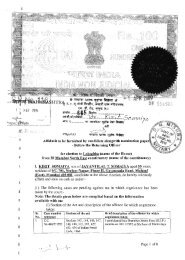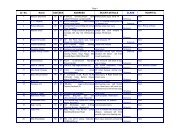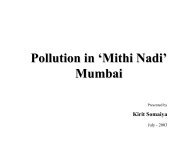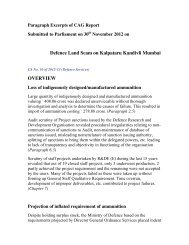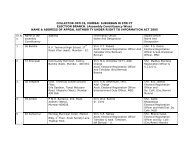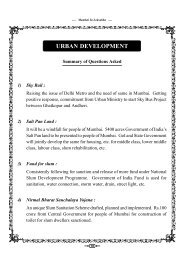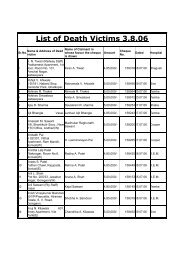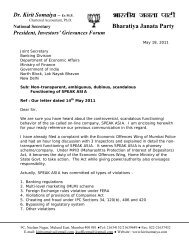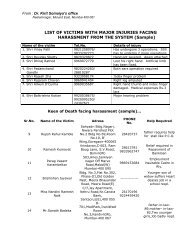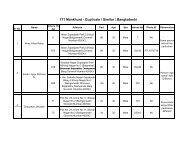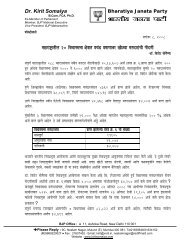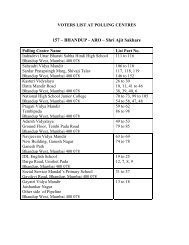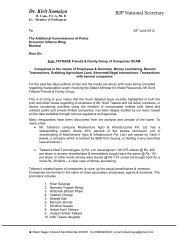flood - KiritSomaiya.com
flood - KiritSomaiya.com
flood - KiritSomaiya.com
You also want an ePaper? Increase the reach of your titles
YUMPU automatically turns print PDFs into web optimized ePapers that Google loves.
Flood Free Mumbai<br />
Concept to Reality<br />
ck< eqDr eqacbZ &,d fu/kkZj<br />
ROADMAP – mik; ; ;kstuk;<br />
Dr. KIRIT SOMAIYA<br />
Ex-Member of Parliament, Vice President BJP Maharashtra
DREAM – REALITY – ACTION PLAN FOR FLOOD FREE MUMBAI<br />
Yes! Really Mithi Nala is be<strong>com</strong>ing once again Mithi River. “LoIu lkdkj gks jgk gS”.<br />
We Mumbaikars can make Mumbai free from <strong>flood</strong>ing and water logging. We are presenting a concept, a blueprint<br />
how we can make our Mumbai “ck< eqDr eqacbZ”.<br />
Request to give your suggestions to correct, improve the Action Plan. We are going to submit Action Plan to all the<br />
authorities – Government of India, Government of Maharashtra, BMC, MMRDA, Corporates, NGOs, Professionals,<br />
Activists, Political leaders, Executives to think at macro level and execute at micro level.<br />
In 2005, it was difficult to dream that we can rejuvenate Mithi River. Court support and monitoring has strengthened<br />
the hands of hard working, efficient engineers and officials. 4000 structures shifted, more than 10,00,000 cubic<br />
meters silt/ mud/ debr removed in the first Phase. 19-km long River is converted from 20-50 ft. to 100 ft. Second<br />
phase planning has started. Work to be started from November. In 3 years, we will have “Dream River – Mithi<br />
River”.<br />
Major problem of monsoon water logging along with <strong>flood</strong>ing. We have played with the waterways. The Financial<br />
Capital of India, has grown from 10 lakh people to 128 lakh population today. But the system, waterways, drains,<br />
rivers have not been updated/upgraded accordingly.<br />
Mumbai is witnessing water logging problem for decades. We have got accustomed to that. In 1980s, 3 days were<br />
lost in a year due to heavy rains and <strong>flood</strong>ing, that too only in the Island City. In 21 st century Mumbai is wasting on<br />
an average 6 days every year during monsoon. Today, just 160 mm rain results in water logging/<strong>flood</strong>ing at more<br />
than 100 places. We have tried to summaries the cause and also suggested solution.<br />
Contd…2.
-- 2 --<br />
Action Plan is for 5 years and cost Rs.3,000 crores. Suggestions for mobilization of resources, corrections in the<br />
policies, immediate measures to stop further deterioration.<br />
The talk of handling the water logging problem of Mumbai is going on since 1991. But till now, Government of India,<br />
Govt. of Maharashtra, have not allotted single paise even after the shocking experience of 26 th July 2005.<br />
Disruption, distress and economic losses have to be considered. During water logging and <strong>flood</strong>ing, the damage<br />
caused is substantial. Disruption of transportation results into disruption of economic activity. This is hurting the<br />
industry and service sector development also. GDP growth of the country reaches 8.5% while that of Mumbai goes<br />
down to 2.1%. People, experts, corporates, professionals, media have started asking question – “Is Mumbai a dying<br />
city?”<br />
The leadership of the Society has to <strong>com</strong>mit itself. Mumbai is losing more than Rs.800 crores per annum due to this<br />
problem. Rs.3,000 crores may be treated as capital investment. Mumbai has given Rs.80,000 crores revenue to<br />
Government of India during 2005-06. Simultaneously, Rs.22,000 crores taxes, dueties, cess has been earned by<br />
Maharashtra Government for the same year. They have to <strong>com</strong>mit and contribute.<br />
The coinciding of heavy rains with high tide is pointed out as the reason of <strong>flood</strong>ing. However, it is not correct to<br />
blame the natural cycle for the <strong>flood</strong>ing. We have to admit that <strong>flood</strong>ing is caused due to human error and<br />
erroneous planning of land use as well as mistakes <strong>com</strong>mitted in terrain management.<br />
The population of Mumbai has grown by 60% , i.e. by 47 lacs in the last 25 years – from 81 lacs in 1981 to 128 lacs in<br />
2006. Of this growth of 47 lacs, 35 lacs is increase in slum population.<br />
Contd…3.
The consequences of <strong>flood</strong>ing are –<br />
-- Misery<br />
-- 3 --<br />
-- Loss of life and property<br />
-- Economic loss to the State and the people<br />
-- Projection of poor image of a global metropolis<br />
To reverse this situation and to establish a <strong>flood</strong> free Mumbai is not a dream. It is practically possible through proper<br />
study, planning and effective implementation.<br />
What we really need is a strong will to achieve this goal. This has to be followed by –<br />
<br />
<br />
<br />
<br />
<br />
<br />
<br />
Systematic <strong>com</strong>pilation of dasta<br />
Review of the work done so far on this issue<br />
Collect suggestions and views of concerned persons regarding the <strong>flood</strong>ing<br />
Prepare action plan<br />
Apply the action plan to select areas to test effectiveness<br />
Apply the successful action plan to other areas in phased manner.<br />
With appropriate methodology, it will be possible to solve this problem permanently.<br />
The following pages of this document will present the case of <strong>flood</strong> free Mumbai. It is hoped that the efforts will be<br />
appreciated by all concerned citizens and we will join hads to solve this Herculean task.<br />
Let us interact, introspect, <strong>com</strong>mit to save our Mumbai – FLOOD FREE MUMBAI.<br />
11 th July 2006 DR. KIRIT SOMAIYA<br />
PS : Request to send suggestions: E-mail : kirit@vsnl.in; kiritsomaiya@gmail.<strong>com</strong>, SMS Mob. No.: 09869220028<br />
BHARATIYA JANATA PARTY
Flooding- Mumbai Perspective<br />
• Flood in Mumbai need not necessarily imply flash<br />
flow of surface runoff washing away everything in<br />
its path.<br />
• In Mumbai <strong>flood</strong> can mean runoff water unable to<br />
be disposed off in reasonable time causing water<br />
logging
Mumbai Island City Born from 7 Original Islands in 16 th Century
Flooding in Mumbai in Nut Shell<br />
• Its water logging & <strong>flood</strong>ing<br />
• Impact of Urban Devt on water-ways<br />
• Mass influx affected plan Devt<br />
• Heavy influx of down trodden in Mumbai<br />
• 1981-2006 population increase 48 lacs i.e. by 60%
Flooding in Mumbai – DNA – 6 July 2006
Flooding in Mumbai in Nut Shell<br />
(Basic Issues)<br />
• Committees & Consultants appointed but Reports<br />
never implimented<br />
• Piecemeal efforts made but no macro level plan &<br />
efforts to solve the problem in totality<br />
• 12 authorities no co-ordination<br />
• No hydrological policy,regulatory or monitoring<br />
system<br />
• Disappearance of open spaces acting as shock<br />
absorber during heavy rain
Flooding in Mumbai in Nut Shell<br />
(Basic Issues continued)<br />
• Inspite of 26 july no action till now<br />
• Govt of India, Planning Commission, Govt of<br />
Maha not given Single Paisa<br />
• Mithi action only due to PIL & Court<br />
• 160mm rain cause water logging at 100 places<br />
• Govt apointed 5 <strong>com</strong>mittees - reports dumped in<br />
cup-boards
HISTORY OF MUMBAI<br />
• Original city of Mumbai consisted of 7 islands – Apollo<br />
Bunder, Malabar, Cumbala, Mazgaon, Worli, Mahim and<br />
Parel-Dharavi-Sion.<br />
• Reclamation interconnection of islands started in 16th<br />
Century.<br />
• Construction of Vellard between Worli and Mahalaxmi<br />
done in 1772.<br />
• Major areas developed in 1850s – Wadi Bunder, Chinch<br />
Bunder, Carnac Bunder, Mint Road, Elphinstone Road,<br />
Tank Bunder, Clerk Road Mahalaxmi, Sewree and Frere<br />
Estate.<br />
• Mahim Causeway developed in the 19th Century.<br />
• Reclamations – Nariman Point (1970s), Bandra<br />
Reclamation (1970s), Bandra Kurla Complex (1980s)
150 yrs. Old Drainage System of Island City
Flooding in Mumbai in Nut Shell<br />
(Island City)<br />
• Loging in island city decades old problem<br />
• Basic capacity of waterways to handle 15mm rain<br />
per hour<br />
• 150 year old planing & system<br />
• Low line areas no major action- till now
Flooding in Mumbai in Nut Shell<br />
(Subarbs)<br />
• Population grown by 67 lacs in 25years<br />
• Subarban population to cross 1 cr in 2008<br />
• Massive encroachments on mouth of major nalas<br />
• Heavy diversions & encroachments of Rivers<br />
• Devt by MMRDA without considering<br />
hydrological impact
Flooding in Mumbai in Nut Shell<br />
(Buildings)<br />
• Population in Building up by 12 lac in 25 yr<br />
• Scarcity of land in Mumbai<br />
• Use of NDZ & Open Spaces<br />
• Massive construction without increasing capacity<br />
of waterways<br />
• Diversons & encroachments of major nalas &<br />
rivers by Private Developers<br />
• Reduction in width &training of nullahs<br />
• Result- disappearance of Holding Ponds
Flooding in Mumbai in Nut Shell<br />
(Slums)<br />
• Massive growth of Slums<br />
• Of 128 lacs 65 lacs stays in slums<br />
• Mumbai population grown 47 lac in 25 yr<br />
• Slum Population grown by 35 lacs in 25 yr<br />
• Encroachments on Water ways<br />
• Slum waste <strong>com</strong>es directly into water ways<br />
• Of 450 lacs slum population of India 65 lacs in<br />
Mumbai
Observations on <strong>flood</strong>ing pattern<br />
• Chronic <strong>flood</strong>ing spots- mostly on the interface<br />
between erstwhile islands???<br />
• Inherently low lying spots<br />
• Largely dependent on tidal variations<br />
• Apart from chronic spots, new areas be<strong>com</strong>ing <strong>flood</strong><br />
prone
Observations on <strong>flood</strong>ing pattern<br />
• Physical obstructions to flow of runoff water on<br />
account of<br />
– Constricted widths of nallas<br />
– Diversion of natural water courses on account<br />
of new developments<br />
• Lack of integrated approach while development of<br />
other infrastructure like new roads- EEH, WEH,<br />
SV Road, LBS Marg etc. are prominent examples
Introspection about the present<br />
drainage system<br />
• City<br />
– Islands converted in<br />
to a single land mass<br />
– Underground SWDs<br />
– Discharging in to sea<br />
through short outfalls<br />
• Suburbs<br />
– Muflats, Mangroves,<br />
Creeks<br />
– Rainwater runoff mostly<br />
in to creeks<br />
– System of open surface<br />
drains
Introspection about the present<br />
drainage system<br />
• Changes in the time taken for runoff/ <strong>flood</strong>water<br />
to recede over a period of time<br />
• Changes in land use pattern<br />
• New development in the catchments<br />
• Changes in Raifall intensity and total rainfall<br />
• Changes in coefficient of runoff<br />
• Changes in the distances or ultimate discharges<br />
• Destruction of mangroves
Limitations of gravity system of drains<br />
• Adversely affected by tidal fluctuations<br />
• Needs proper gradient- resulting in to driving head<br />
for flow<br />
• Affected by acute changes in direction<br />
• Considered to be non-priority over other services
Paradigm shift in system design<br />
• Integrated approach to design of infrastructure like roads<br />
with due consideration for SWD and sanitary drainage<br />
system<br />
• Complete systems approach rather than piecemeal<br />
approach<br />
• Whole to part approach with identification of cause of<br />
problem<br />
• Review of design basis<br />
• Operation and maintenance aspects<br />
• Regional overview along with locally implementable<br />
measures
Identification of cause at every level<br />
• Starting from the local level, tracing the cause till<br />
the regional level<br />
• Identification such local spots with people’s active<br />
participation<br />
• Identification of reasons from people’s perspective<br />
• Application of the information and data collection<br />
for system design
Impact of Development<br />
• Cement Concretization of Roads<br />
• Increase in height of Roads, Asphalting<br />
• Widening of major Roads and Construction of<br />
Service Road<br />
• Its impact on Roadside Waterways, Drains etc.<br />
• Effect on water absorbing capacity & system<br />
• Flow of storm water be considered at the time of<br />
Road Development
Need to Study - Impact of<br />
redevelopment on Waterways<br />
• Mill lands<br />
• Dharavi Redevelopment<br />
• SRA/ PAP at Anik<br />
• Mankhurd<br />
• Salt Pan<br />
• BPT Land<br />
• Metro Railway
Slum Population and facilities in slums<br />
• More than half of city’s Population live in SLUMS<br />
• 65 lacs Slum Dwellers in Mumbai.<br />
• SLUMS are un-planned under served<br />
• Located in HIGH RISK and BARELY<br />
HABITABLE areas of city.<br />
• Poorly equipped with Sanitation and Solid Waste<br />
collection facilities.
History Of Sewerage & Drains System<br />
• Old main drain constructed by end of 18th century.<br />
• In 1860, Vihar Lake <strong>com</strong>missioned.<br />
• By end 1867, main sewer outlets were laid.<br />
• From 1882 onwards, sewerage work in Queen’s<br />
Road, Fort area and Girgaum undertaken.;
Statistical Data Of Mumbai’s s Drainage<br />
System Network<br />
Length of Nallas and Drains
System of SWD Outfalls for Disposal of<br />
Rainwater in Mumbai
Outfall levels vis-à-vis Mean Sea Level -<br />
High Flood Level<br />
(A) Outfalls below Mean Sea Level = 45<br />
(B) Outfalls above MSL but below High tide level = 135<br />
(C) Outfalls above High tide level = 6
Major outfalls<br />
• Outfall Invert Level below Mean Sea Level = 45 Nos<br />
• Outfall Invert Level above Mean Sea Level = 135 Nos<br />
• Outfall Invert Level above High Tide Level = 6 Nos
Major water-logging CR<br />
• Masjid Bunder<br />
• Byculla<br />
• Sion<br />
• Chunabhatti<br />
• Kurla Stn.<br />
• Vidya Vihar, near Fatima School<br />
• Bhandup Station
Major water-logging WR<br />
• Grant Road<br />
• Mumbai Central<br />
• Lower Parel
Railway Culverts (Nos(<br />
Nos)
Lakes of Mumbai<br />
• Tulsi Lake: 114.74 m GTS. Dam has two ungated<br />
spillways. One spillway at crest level is situated at 115.42 m<br />
GTS. This spillway discharges into Dahisar River. The other<br />
spillway at 114.74 m GTS discharges into Vihar Lake.<br />
• Vihar Lake: The FSL of the lake is 56.21 m GTS and foot<br />
of the dam is 27.36m GTS. This dam is also having ungated<br />
(i.e., unregulated) spillway. The Vihar Lake spillway<br />
discharges into Mithi River.<br />
• Powai Lake: The FSL of the lake is 94.97 m GTS. This<br />
spillway discharge also meets Mithi River.
• Mumbai have 7 Rivers –<br />
Mithi, Mahul, Vakola,<br />
Oshiwara, Poisar, Walbhat,<br />
Dahisar & 3 Lakes - Tulsi,<br />
Vihar & Powai<br />
• Development at the cost of<br />
Rivers – Slowly, steadily<br />
one by one River getting<br />
disappeared.<br />
• Mahul River and Vakola<br />
River (2 branches of Mithi)<br />
existed till 1976 on Map.<br />
• D.P. City Map doesn’t<br />
exist now.
Mithi River - Facts<br />
• Origin - Sanjay Gandhi National Park - overflow of Vihar<br />
and Powai dams.<br />
• Length - 17.9 km<br />
• Flow of River - Sanjay Gandhi National Park, Aarey<br />
colony, Filter Pada, L & T Jn., JVLR, Saki Naka, Kranti<br />
Nagar, Bail Bazar, Air Port, BKC<br />
• Meeting point - Mahim Creek<br />
• Total Catchment area - 7,295 ha <strong>com</strong>prising of 21<br />
catchments based on the BRIMSTOWAD report
Mithi River – Facts (Contd(<br />
Contd…)<br />
• Reasons for degradation –<br />
– Narrowing of the bank<br />
– Runway Extension of the Santacruz Airport<br />
– Reclamation of River bed for industrial units<br />
– Diversion of River flow due to dumping of construction<br />
debris/ solid waste/ industrial waste<br />
– Industrial Waste
Unnatural 90 0 diversion of Mithi for development of Airport.<br />
One of the major problem un-natural natural diversions of Water ways
Development of last 20 yrs have converted Mithi River into Mithi Nalla.<br />
In 1976 Mithi was more than 200 ft. wide as shown in black boundary.<br />
By 2005 – 19 kms. . Long river was converted into a nalla of 22 to 62 ft.
Cwprs Major Re<strong>com</strong>mendations (1978)<br />
Not Implemented<br />
• Increase the width to 200 meters from BKC to Mahim<br />
creek.<br />
• It has remained 85 to 115 meters only<br />
• Mithi-Vakola Nala width to be increased to 60 meters.<br />
• It has remained 20 to 40 meters.<br />
• Provision of sluice gates at Mahim Causeway.<br />
• Had all these re<strong>com</strong>mended works been <strong>com</strong>pleted,<br />
impact of 26 th July would have been much less.
Mithi – Mahul / Thane Creek Connection<br />
• Water courses to be planned- connected by<br />
water-shed approach<br />
• Development in Mumbai have detached/<br />
separated natural water courses<br />
• Major Rivers & Water flows isolated by<br />
development<br />
• E.g.- Britannia, Senapati Bapat Marg, in City<br />
and Thane, Mahul & Mahim Creek in suburb
Suggested Zoning & Channelization widths of River in Mumbai<br />
NOTE: CWPRS Reports of 1978 & 2006 suggested width of Mithi to be increased to 60mtr to 200 mtr
Dahisar River - Facts<br />
• Length - 12 km<br />
• Flow of River - National Park, Sri Krishna Nagar,<br />
Daulatnagar, Leprosy Colony, Kandar Pada, Sanjay<br />
Nagar, Dahisar Gaonthan<br />
• Meeting point - Bhayander Creek (i.e. Manori<br />
Creek)
Poisar River<br />
• Point of origin - Sanjay Gandhi National Park, Kranti<br />
Nagar, Kandivli (East)<br />
• Length –7 Km<br />
• Areas – Appa Pada, Kurar Village, Hanuman Nagar,<br />
Thakur Complex, Mahindra & Mahindra, Poisar<br />
• Major Nallas associated – Samta Nagar, Thakur<br />
Complex, Asha Nagar, Joglekar, Magitia, Kamla Nehru<br />
road, vickers Spery<br />
• Meetign Point – Malad Creek.<br />
• Total Catchment – 2,095 ha
Oshiwara River<br />
• Point of Origin – Aarey Milk Colony, Goregaon (E)<br />
• Length –7 km<br />
• Areas – Aarey Colony, Pahadi Area, walbhat Road,<br />
Jawahar Nagar, Oshiwara, Motilal Nagar, Link Road,<br />
Malad Creek.<br />
• Major Nallas associated – Majas, Oshiwara River,<br />
Gogatewadi, Shastri Nagar, Bimbisar Nagar.<br />
• Meeting point – Malad Creek.<br />
• Total area – 2,938 ha
Holding Ponds – Shock Absorbers during Heavy Rain<br />
• Holding Ponds – Open Spaces getting disappeared<br />
• Holding Ponds help to absorb and act as Buffer Zone during heavy<br />
rain<br />
• Being filled by land for development activities<br />
• Release for development for SRA, PAP etc.<br />
• Policy for Development of Open Places, NDZ, CRZ needs serious<br />
thinking<br />
• Holding Basins<br />
• Eastern – Vikhroli, Kanjur, Bhandup, Mulund, Ghatkopar,<br />
Mankhurd<br />
• Western – Mahim Nature Park, Bandra (E), Oshiwara, Anik
Dahisar –Oshiwara<br />
& Other Rivers -<br />
Rejuvenation<br />
• Study on Flood Mitigation Measures for Dahisar, Poisar &<br />
Oshiwara in North Mumbai – Interim Report – Dec 2005 by<br />
Water & Power Consultancy Services (India) Ltd. Gurgaon
BRIMSTOWAD Report<br />
To Suggest Solutions<br />
• Submitted in November 1990.<br />
• To be implemented in 12 years from 1994 to 2005.<br />
• Not implemented till now.<br />
• Study of problem of water logging and <strong>flood</strong>ing.<br />
• Action plan suggested to protect Mumbai against<br />
monsoon <strong>flood</strong>ing.<br />
• Action plan for revival, reconstruction, maintenance<br />
of major nadi, nalas.
Engineering Actions-<br />
BRIMSTOWAD Report<br />
• Increasing capacity of Drains<br />
• Storing flows to reduce peak discharges<br />
• Installation of Pumping system<br />
• Installation of Sluice gates<br />
• Special action for Mithi River<br />
• To keep drains mud free
Major catchments - BRIMSTOWAD<br />
• Catchments more than 1000 Ha = 6 Nos.<br />
• Catchments between 100 Ha and 1000 Ha = 30 Nos.<br />
• Catchments less than 100 Ha = 41 Nos.<br />
• Catchments having outfall below Mean Sea Level are 45<br />
Nos
Total Investment – Island City<br />
1992)<br />
(BRIMSTOWAD<br />
1992)
Total Investment – Island City<br />
(BRIMSTOWAD 1992)
Total Investment – Suburb (BRIMSTOWAD 1992)
Total Investment – Suburb (BRIMSTOWAD 1992)
OBSTRUCTIONS DUE TO PUBLIC<br />
UTILITY SERVICES<br />
• Water pipes, electricity cables, TV internet cables,<br />
telephone cables affect flow of water.<br />
• Identification of such lines in nallas required.<br />
• Action plan for shifting required.
Encroachments in the riverbeds<br />
• Open, dangling cable and pipe crossings on the sides<br />
of the bridges and culverts,<br />
• Debris dumping (from construction activities as well<br />
as industrial wastes) on banks and into rivers,<br />
• Sedimentation in river beds and dumping of urban<br />
solid wastes into rivers coupled with inadequate<br />
annual desilting efforts,<br />
• Ingress encroachments from the banks ( building,<br />
industries, and slums)<br />
• Modification of river – courses and local diversion of<br />
streams.
Coastal Zones and Mangrove-Ecosystem<br />
• Length – 52 kms<br />
• Names of Bays – Mahim Bay, Haji Ali, Worli (bay like)<br />
• Names of Major Creeks – Thane, Mahim Versova, Manori, Gorai<br />
• Names Of Rivers – MIthi, Dahisar, Poisar, and Oshiwara<br />
• Major Nallas – several nallas in suburbs joining above rivers and<br />
creeks<br />
• Salt pan – Along the estern express highway, anik – Wadala road<br />
• Total Cathment Area – 12,986 ha<br />
• Names of Beaches – Girgaon, Dadar, Mahim, Juhu, Versova,<br />
malad, Gorai, Mudh lsland, etc.<br />
• Rock-outcrops and Mudflats – Colaba, Worli, Bandra, Khar, and<br />
mudflats (i.e.wetland)
Framework for Addressing Environmental<br />
Challenges in Mumbai’s s Urban Management<br />
• Sustainable development should be our ultimate<br />
objective<br />
• Adoption of ‘polluter pays principle’<br />
• Adoption of ‘precautionary principle’<br />
• Ecosystem services are not adequately quantified in<br />
<strong>com</strong>mercial markets and are often given too little<br />
weight in policy decisions objective<br />
• The ‘system’s approach’ and ‘watershed’ based<br />
development planning
Observations of Chitale Committee<br />
• Guidelines for other improvements<br />
• -- Hydrological monitoring<br />
• -- Sensing by radars<br />
• -- Topographical contours<br />
• -- Upgraded Railway culverts<br />
• -- Resettlement<br />
• -- Restructuring of MMRDA<br />
• -- Financial support
Plethora of Committees – Reports but no<br />
Implementation<br />
• Natu Committee – 1975<br />
• CWPRS - 1978 on Development of Bandra-Kurla Complex.<br />
• Dharavi storm Water Drainage System – Shah Technical<br />
Consultants – (STC)1988<br />
• BRIMSTOWAD report – 1993<br />
• Mirani Committee – 1997 & 2005<br />
• Flooding at Milan Subway & Grant road / Nana Chowk – 2005<br />
by I.I.T. Powai.<br />
• CWPRS & IIT – 2005-06 on Mithi River<br />
• Chitale Committee – 2005-06
FINANCIAL – ECONMIC LOSSES<br />
• Water logging/<strong>flood</strong>ing problem for a minimum of 6<br />
days in a year.<br />
• Half of the city is not able to function for 6 days.<br />
• Losses due to impact on production, services, export,<br />
etc.<br />
• Losses for deterioration of roads due to <strong>flood</strong>ing.<br />
• Water logging in residential, <strong>com</strong>mercial, industrial<br />
areas affect life of structures.<br />
• Recurring expenditure for repairing and maintenance.<br />
• Loss of human life, human health.
Eastern Express Highway – Photo DNA 6 th July 2006
FINANCIAL – ECONMIC LOSSES<br />
(Contd.)<br />
• Losses of goods and materials in shops and godowns.<br />
• Loss of household goods in buildings and slums.<br />
• Losses due to impact of life of buildings/structures.<br />
• Losses of trade, export, production & service.<br />
• Losses due to water-borne disease – its impact on<br />
health.<br />
• Impact on the life of roads.<br />
• Effect and impact on life of vehicles, repairs and<br />
insurance
FINANCIAL – ECONMIC LOSSES –<br />
FUTURE & GROWTH<br />
• Long term impact on growth and future of Mumbai.<br />
• Direct impact on the growing financial services.<br />
• Direct impact on BPO, Call Centre, etc.<br />
• Additional expenditure for maintenance, repair by<br />
various authorities including Railways, Airports,<br />
BEST, etc.
FINANCE & ECONOMIC LOSSES -<br />
PROJECTION<br />
• Country’s GDP growth at 8.5% and Mumbai down to 2.1%.<br />
• Losses to Property, Productions, Services, Health, Transport,<br />
Travelling & Human Life<br />
• Per day Finance & Economic losses - Rs.150 Cr. to 200<br />
Crores<br />
• Average 6 days heavy water logging and <strong>flood</strong>ing problem.<br />
• Total losses per year – Rs.800 Cr. To Rs.1,000 Cr.
FINANCE - RESOURCES REQUIRED<br />
• Mithi River revival<br />
• Dahisar, Poisar, Oshiwara, Mahul River Projects<br />
• Major nalas/SVD development – restructuring<br />
• Work of natural flow, desilting, deepening, widening<br />
of major nallas
FINANCE - RESOURCES REQUIRED<br />
(contd.)<br />
• Removal/shifting of unauthorized structures on the nallas<br />
• Rehabilitation of affected people<br />
• Development of holding ponds<br />
• Development/upgradation of Central water monitoring<br />
agency/system<br />
• Inter-connection of rivers and nalas<br />
• Total cost Rs.3,000 Cr.+Rs.1,000 Crores
Way to mobilize Finance - Resources<br />
• Rs.4,000 crores mobilization in next 5 years.<br />
• Additional provision by BMC of Rs.1,000 crores @<br />
Rs.333 crores for the next 3 years.<br />
• Rs.1,000 crores contribution by MMRDA.<br />
• Rs.1,200 crores by Central Govt. through Planning<br />
Commission.<br />
• Rs.800 crores by State Govt. through its matching<br />
contribution for Central schemes and support.
Way to mobilize Finance - Resources<br />
BENEFICIARY AGENCIES<br />
• MMRDA by selling of land.<br />
• MHADA by sale of developed houses.<br />
• Collector /State Govt. – By sale of Govt. plots.<br />
• Railways – Mumbai, the main junction, and heavy<br />
goods traffic.<br />
• Airport |Authorities.
Responsibilities of stakeholders<br />
• BMC<br />
• MMRDA<br />
• Railways<br />
• Govt. of India<br />
• Govt. of Maharashtra<br />
• Political Leadership & Executives<br />
• NGOs, Citizen Organizations & Corporates
Way to mobilize Finance - Resources<br />
AGENCIES TO CONTRIBUTE<br />
• BMC have Rs.10,000 crores annual budget.<br />
• MMRDA – real beneficiary of land development at Bandra<br />
Kurla Complex.<br />
• MMRDA had earned/to earn Rs.25,000 crores by selling land of<br />
Mumbai<br />
• Railways, Airport Authorities, Port Trust, Defence, Navy,<br />
Central Govt. agencies use Mumbai.<br />
• Central Govt. earned Rs.80,000 crores as taxes during 2005-06<br />
from Mumbai.<br />
• State Govt. earned Rs.22,000 crores taxes and revenue from<br />
Mumbai.
Approach Required<br />
• Long term vision<br />
• Review of earlier masterplans and reports<br />
• Changes in system design<br />
• Identification of priority spots<br />
– Develop solution for these spots at local level but with regional approach<br />
• Emphasis on quick drainage<br />
• Development of natural water courses/ rivers<br />
• Implementation in phases with proper prioritization<br />
• Implementation strategy<br />
– Restoration/ development of drainage system<br />
– Resettlement of PAP<br />
• Development regulations<br />
– DC rules<br />
• Coordinated clearances<br />
– Obligations for the developers<br />
– Buffer zone
Major Actions Needed<br />
• Macro and micro level execution system.<br />
• Time bound action plan of 5 years.<br />
• Financial support and mobilization of Rs.4,000<br />
crores.<br />
• Govt. of India, State Govt., MMRDA, BMC can<br />
contribute and mobilize Rs.4000 crores.<br />
• Formation of River Authority for all the rivers –<br />
Mithi, Dahisar, Poisar, Oshiwara and Mahul.<br />
• Review & updation of BRIMSTOWAD, Chitale<br />
Committee re<strong>com</strong>mendations.<br />
• Removal of encroachment on and at the<br />
waterways, river, major nalas.
Major Actions Needed (Contd(<br />
Contd…)<br />
• Multiple Agencies (15 Authorities)<br />
develops & maintain Roads & Drains<br />
• BMC,, BPT, CR, WR, Harbor Line, PWD,<br />
MSRDC, Collector, Airport Authority, State<br />
Govt., Central Govt., Defence/ Navy,<br />
MHADA, MMRDA<br />
• Individual planning & execution by these<br />
agencies affects waterways & flows
Major Actions Needed (Contd(<br />
Contd…)<br />
• Need for micro level planning & execution<br />
• Presently no agency studied & examined<br />
waterway requirement in totality<br />
• Absence of Apex Authority for Hydrological<br />
Issues<br />
• Further development should be allowed only<br />
after considering its impact on waterways<br />
• BMC, Hydrological Dept. should act as Apex<br />
Body<br />
• BMC Should be only body to take decision on<br />
drainage system
Development Of Individual<br />
Catchments Systems<br />
• Mithi- Vakola system<br />
• Dahisar<br />
• Oshiwara- Walbhat System<br />
• Poisar<br />
• Mahul<br />
• Non-river catchments
Development/ Improvement Of<br />
• System Assessment<br />
• Hydraulic<br />
• Structural<br />
• Functional<br />
• Capacity augmentation<br />
• Pumping stations<br />
• Holding basins<br />
• Gates<br />
• New drains<br />
Drainage System
Administrative Reforms<br />
• Assigning responsibility to a single body rather than<br />
involving multitude of bodies<br />
• BMC which under the BMC act is responsible for<br />
development and maintenance of drainage should be<br />
properly empowered to take necessary steps even in<br />
respect of other infrastructure development like raods or<br />
transportation network by MMRDA, Railways etc.<br />
• Monitoring responsibility<br />
• Allow engineering approach to prevail over the<br />
bureaucratic approach for preventing arbitrary<br />
implementation<br />
• Stricter enforcement of legislative provisions
Action In Phases - Immediate Measures<br />
– Apex body for hydrological clearances for any<br />
development<br />
– Formation River Authority<br />
– Freezing of NDZ clearances<br />
– Stoppage further diversion/ remodeling of nallas in<br />
the name of development<br />
– Change of user proposals must be vetted with due<br />
consideration for hydrological impact
Action in Phases - Phase I<br />
• Period : 2006 to 2008<br />
•System assessment<br />
• Capacity Enhancement in Island City<br />
– Desilting<br />
– Condition improvement<br />
– Pumping stations<br />
• Implementation of Mithi Phase II for suburbs
Action in Phases - Phase II<br />
• Period : 2008 to 2012<br />
• Development of holding basins<br />
• Implementation of river plans<br />
• Rehabilitation/ New drains in City as well as<br />
suburbs<br />
• Gates<br />
• Pumping station
ACKNOWLEDGEMENT<br />
• This is to acknowledge help of the data,<br />
material and interaction from following :–<br />
– Chitale Committee Report<br />
– CWPRS Report<br />
– IIT Report<br />
– BRIMSTOWAD Report<br />
– Media reports<br />
– Officials, Experts & Activists





